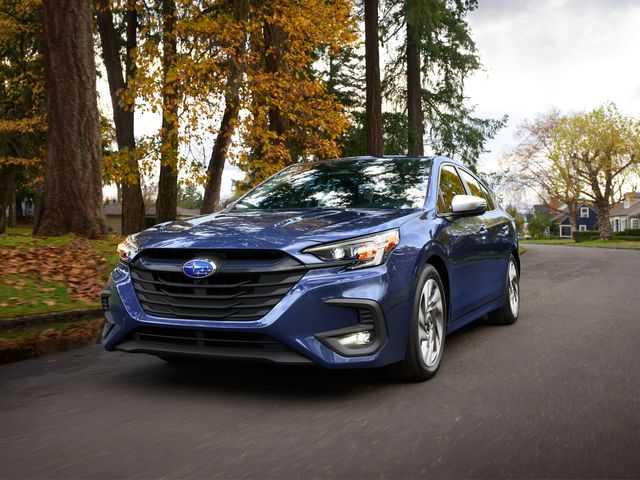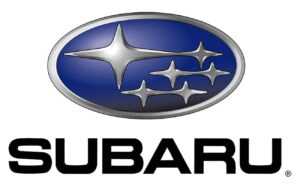Subaru Legacy 2023 vehicle break-in driving – the first 1,000 miles
To guarantee the long-term longevity and peak performance of the 2023 Subaru Legacy Touring XT, a recommended break-in driving period of roughly 1,000 miles (or 1,600 kilometers) is included in the package. It is advised that drivers use cautious driving techniques during this time, steering clear of sudden acceleration, fast speeds, and large loads. The idea is to give the engine and other parts time to stabilize and adjust. While driving on a highway is legal, it is recommended to avoid sustained speeds above 55 mph (88 km/h) and to vary your pace. Following these recommendations can help owners of Legacy Touring XTs maintain optimal economy and performance over time, demonstrating Subaru’s dedication to long-term car longevity and customer happiness.
2024 Subaru Legacy Specs, Price, Features, Mileage (Brochure)
New vehicle break-in driving – the first 1,000 miles (1,600 km)
The performance and long life of your vehicle are dependent on how you handle and care for the vehicle while it is new.
Follow these instructions during the first 1,000 miles (1,600 km):
- Do not race the engine. Do not allow engine speed to exceed 4,000 rpm except in an emergency.
- Do not drive at one constant engine or vehicle speed, either fast or slow.
- Avoid starting suddenly and rapid acceleration, except in an emergency.
- Avoid hard braking, except in an emergency.
- The same break-in procedures should be applied to an overhauled engine, newly mounted engine or when brake pads are replaced with new ones.
Fuel economy hints
The following suggestions will help to save fuel:
- Select the proper gear position for the speed and road conditions.
- Avoid sudden acceleration or deceleration. Always accelerate gently until you reach the desired speed. Then try to maintain that speed for as long as possible.
- Do not pump the accelerator and avoid racing the engine.
- Avoid unnecessary engine idling.
- Keep the engine properly tuned.
- Keep the tires inflated to the correct pressure shown on the tire inflation pressure label, which is located under the door latch on the driver’s side. Low pressure will increase tire wear and fuel consumption.
- Use the air conditioner only when necessary.
- Keep the front and rear wheels in proper alignment.
- Avoid carrying unnecessary luggage or cargo.
- The indication of the ECO gauge shows a reference for saving fuel.
Engine exhaust gas (carbon monoxide)
- Never inhale engine exhaust gas. Engine exhaust gas contains carbon monoxide, a colorless and odorless gas that is dangerous, or even lethal if inhaled.
- Always properly maintain the engine exhaust system to prevent engine exhaust gas from entering the vehicle.
- Never run the engine in a closed space, such as a garage, except for the brief time needed to drive the vehicle in or out of it.
- Avoid remaining in a parked vehicle for a long time while the engine is running. If that is unavoidable, then use the ventilation fan to force fresh air into the vehicle.
- Always keep the front ventilator inlet grille free from snow, leaves, or other obstructions to ensure that the ventilation system always works properly.
- If at any time you suspect that exhaust fumes are entering the vehicle, have the problem checked and corrected as soon as possible. If you must drive under these conditions, drive only with all windows fully open.
- Keep the rear gate closed while driving to prevent exhaust gas from entering the vehicle.
NOTE
Due to the expansion and contraction of the metals used in the manufacture of the exhaust system, you may hear a crackling sound coming from the exhaust system for a short time after the engine has been shut off. This sound is normal.
Catalytic converter
- Avoid fire hazards. Do not drive or park the vehicle anywhere near flammable materials (e.g. grass, paper, rags or leaves), because the catalytic converter operates at very high temperatures.
- Keep everyone and flammable materials away from the exhaust pipe while the engine is running. The exhaust gas is very hot.
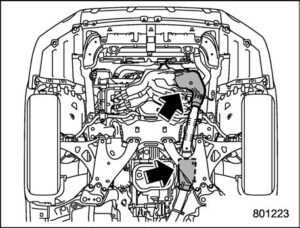
2.5 L models
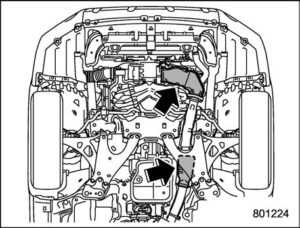
2.4 L models
The catalytic converter is installed in the exhaust system. It catalyzes to reduce HC, CO and NOx in exhaust gases, thus providing cleaner exhaust.
To avoid damage to the catalytic converter:
- Use only unleaded fuel. Even a small amount of leaded fuel will damage the catalytic converter.
- Never start the engine by pushing or pulling the vehicle.
- Avoid racing the engine.
- Never turn the ignition switch to the “OFF” position while the vehicle is moving.
- Keep your engine tuned up. If you feel backfiring or incomplete combustion), have your vehicle checked and repaired by an authorized SUBARU dealer.
- Do not apply undercoating or rust-prevention treatment to the heat shield of the catalytic converter and the exhaust system.
- Do not drive with an extremely low fuel level.
Periodic inspections
To keep your vehicle in the best condition at all times, always have the recommended maintenance services listed in the maintenance schedule in the “Warranty and Maintenance Booklet” performed at the specified time or mileage intervals.
Driving in foreign countries
When planning to use your vehicle in another country:
- Confirm the availability of the correct fuel.
- Comply with all regulations and requirements of each country
Driving tips for AWD models
- Always maintain a safe driving speed according to the road and weather conditions to avoid having an accident on a sharp turn, during sudden braking or under other similar conditions.
- Always use the utmost care in driving – overconfidence because you are driving an All- All-wheel drive vehicle could easily lead to a serious accident.
- When replacing or installing tire(s), all four tires must be the same for the following items.
- Size
- Speed Symbol
- Load Index
- Circumference
- Construction
- Manufacturer
- Brand (tread pattern)
- Degrees of wear
- For items (a) to (c), you must obey the specification that is printed on the tire inflation pressure label. The tire inflation pressure
label is located on the driver’s door pillar. If all four tires are not the same for items (a) to (h), serious mechanical damage could be caused to the drivetrain of the car, and affect the following.- Ride
- Handling
- Braking
- Speedometer/Odometer calibration
Clearance between the body and tires It also may be dangerous and lead to loss of vehicle control, and it can lead to an accident.
CAUTION
If you use a temporary spare tire to replace a flat tire, be sure to use the original temporary spare tire stored in the vehicle. Using other sizes may result in severe mechanical damage to the drivetrain of your vehicle.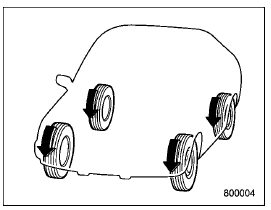
All-wheel drive distributes the engine power to all four wheels. AWD models provide better traction when driving on slippery, wet or snow-covered roads and when moving out of mud, dirt, and sand. By shifting power between the front and rear wheels, SUBARU AWD can also provide added traction during acceleration and added engine braking force during deceleration. Therefore, your SUBARU AWD vehicle may handle differently than an ordinary two-wheel drive vehicle and it contains some features unique to AWD. For safety purposes as well as to avoid damaging the AWD system, you should keep the following tips in mind.
- An AWD model is better able to climb conditions than a two-wheel drive vehicle. There is little difference in handling, however, during extremely sharp turns or sudden braking. Therefore, when driving down a slope or turning corners, be sure to reduce your speed and maintain an ample distance from other vehicles.
- Always check the cold tire pressure before starting to drive. The recommended tire pressure is provided on the tire inflation pressure label, which is located under the door latch on the driver’s side.
- Frequent driving of an AWD vehicle under hard-driving conditions such as steep hills or dusty roads will necessitate more frequent replacement of the following items than that specified in the “Warranty and Maintenance Booklet”.
- Engine oil
- Brake fluid
- Rear differential gear oil
- Continuously variable transmission fluid
- Front differential gear oil
There are some precautions that you must observe when towing your vehicle.
On-Road and Off-Road Driving
- Always maintain a safe driving speed according to the road and weather conditions to avoid having an accident on a sharp turn, during sudden braking or under other similar conditions.
- Always use the utmost care in driving – overconfidence because you are driving an All-Wheel Drive vehicle could easily lead to a serious accident.
- In a rollover crash, an unbelted person is significantly more likely to die than a person wearing a seatbelt. The driver and all passengers should fasten their seatbelts before starting to drive to minimize the chance of serious injury or death.
- Do not make sharp turns or quick maneuvers unless unavoidable. Such actions are dangerous, as you may lose control, possibly resulting in a rollover which could cause death or serious injury.
- Whenever strong crosswinds are present, slow down sufficiently to maintain control of your vehicle. Remember that your vehicle, with its higher profile and center of gravity, is more likely to be affected by crosswinds than ordinary passenger cars.
- Never attempt to drive through pools and puddles, or roads flooded with water. Water entering the engine air intake or the exhaust pipe or water splashing onto electrical parts may damage your vehicle and may cause it to stall. In this case, contact your SUBARU dealer immediately. Regardless of its depth, it can wash away the ground from under your tires, resulting in possible loss of traction and even vehicle rollover.
CAUTION
After driving on gravel roads or rough roads, check the undercarriage of the vehicle body for any damage, deformation, or paint removal. If you notice any irregularities, contact a SUBARU dealer for an inspection as soon as possible.
Legacy
Your AWD vehicle is neither a conventional off-road vehicle nor an all-terrain vehicle. It is a passenger car designed primarily for on-road use. The AWD feature gives it some limited off-road capabilities in situations in which the driving surface is relatively level, obstruction-free, and otherwise similar to on-road driving conditions. Operating it under other than those conditions could subject the vehicle to excessive stress which might result in damage not eligible for repair under warranty. If you do take your SUBARU off-road, you should review the common sense precautions in the next section (applicable to the Outback/Subaru Outback Wilderness) for general guidance. But please keep in mind that your vehicle’s off-road capabilities are more limited than those of the Outback/Subaru Outback Wilderness.
Outback/Subaru Outback Wilderness
Frequent driving of an AWD model under hard-driving conditions such as rough roads or off roads will necessitate more frequent replacement of the following items than that specified in the maintenance schedule described in the “Warranty and Maintenance Booklet”.
- Engine oil
- Brake fluid
Remember that damage done to your SUBARU while operating it off-road and not using common sense precautions such as those listed above is not eligible for warranty coverage. Your vehicle is classified as a utility vehicle. A utility vehicle features a high ground clearance and may be equipped with off-road tires (Subaru Outback Wilderness models only), which enable the vehicle to be used for a wider range of applications. Because of the AWD feature and higher ground clearance, you can drive your SUBARU on ordinary roads or off-road. It handles and maneuvers differently from many passenger vehicles both on-road and off-road, so take time to become familiar with your vehicle. Note, however, that your vehicle is not a conventional off-road vehicle or an all-terrain vehicle, and it should not be operated like one. A higher center of gravity about the tread width as compared with ordinary passenger cars makes vehicles of this type more likely to roll over. In reality, utility vehicles have a significantly higher rollover rate than other types of vehicles. The high ground clearance of this vehicle is a real advantage, giving you a better view of the road and allowing you to anticipate problems earlier. However, remember that your utility vehicle is not designed for high-speed cornering comparable to ordinary passenger cars and that your vehicle could roll over if you make a sharp turn at high speed. If you do take your SUBARU off-road, certain common sense precautions such as those in the following list should be taken.
Before driving
- Make certain that you and all of your passengers are wearing seatbelts.
- Carry some emergency equipment, such as a towing rope or chain, a shovel, wheel blocks, a first aid kit, and a cell phone or citizens band radio.
- Secure all cargo carried inside the vehicle and make certain that it is not piled higher than the seatbacks. During sudden stops or jolts, unsecured cargo could be thrown around in the vehicle and cause injury. Do not pile heavy loads on the roof. Those loads raise the vehicle’s center of gravity and make it more prone to tip over.
- Never equip your vehicle with tires larger than those specified in this manual.
During driving
General precautions:
- Drive carefully. Do not take unnecessary risks by driving in dangerous areas or over rough terrain.
- Slow down and employ extra caution at all times. When driving off-road, you will not have the benefit of marked traffic lanes, banked curves, traffic signs, and the like.
- Do not drive across steep slopes. Instead, drive either straight up or straight down the slopes. A vehicle can much more easily tip over sideways than it can end over end. Avoid driving straight up or down slopes that are too steep.
- Avoid sharp turning maneuvers, especially at higher speeds.
- Do not grip the inside or the spokes of the steering wheel. A bad bump could jerk the wheel and injure your hands. Instead, drive with your fingers and thumbs on the outside of the rim.
- Do not drive or park over or near flammable materials such as dry grass or fallen leaves, as they may burn easily. The exhaust system is very hot while the engine is running and right after the engine stops. This could create a fire hazard.
Precautions when driving under especially dangerous situations: - When driving over bumps in the road, drive as slowly as possible to avoid damaging the wheels, underside of the vehicle, etc.
- If driving through water, such as when crossing shallow streams:
- First, check the depth of the water and the bottom of the stream bed for firmness.
- Next, ensure that the bed of the stream is flat.
- Then, drive slowly and completely through the stream. The water should be shallow enough that it does not reach the vehicle’s undercarriage.
- If you must rock the vehicle to free it from sand or mud, depress the accelerator pedal slightly and move the select lever back and forth between “D” and “R” repeatedly. Do not race the engine. For the best possible traction, avoid spinning the wheels when trying to free the vehicle.
- Do not perform the following operations. Doing so may cause the transmission to overheat or malfunction.
- Depressing the accelerator pedal and brake pedal at the same time while the select lever is in a position other than “P” or “N”.
- Depressing the accelerator to hold the vehicle in a stationary position while on a slope and while the select lever is in a position other than “P” or “N”.
- Trying repeatedly to drive over a bump that the vehicle cannot climb over.
- When the road surface is extremely slippery, you can obtain better traction by starting the vehicle with the transmission in 2nd than 1st. Refer to “Selection of Manual Mode”
- Do not rotate the tires at a high speed if the vehicle is stuck due to muddy, snowy, icy, or similar low-traction conditions, or if any tire is not touching the ground. Doing so may cause the tires to burst or lead to an accident due to abnormal overheating or damage to drivetrain components.
- On rough roads and roads with large undulations, have a leader guide you, or check the road surface in advance to select a road where the ground will not come in contact with the undercarriage of the vehicle body.
Drive the vehicle at 6 mph (10 km/h) or less. If you hear any abnormal noise while driving, contact a SUBARU dealer for an inspection as soon as possible. - Do not allow the vehicle tires to be submerged in deep sand, a river, or seawater. If you have to drive under these conditions, thoroughly wash the vehicle after driving. If you hear any abnormal noise while driving, contact a SUBARU dealer for an inspection as soon as possible.
- If the wheels are stuck, cutting the steering wheel at a sharp angle may cause the steering components to be deformed. If you hear any abnormal noise while driving or if you notice any abnormalities due to rough running, contact a SUBARU dealer for an inspection as soon as possible.
- Avoid driving over curbs. Tires, wheels, suspensions, and the mechanical components under the vehicle body may be unnoticeably damaged by the impact of striking a curb or driving on a rough road. If driving over a curb is unavoidable, ride over it slowly and at a right angle to the curb. When parking your vehicle, make sure that the tires are not pressed against the curb.
- Do not drive for a long time while the vehicle is tilted to the left or right.
After driving
- Always check your brakes for effectiveness immediately after driving in sand, mud or water. Do this by driving slowly and stepping on the brake pedal. Repeat that process several times to dry out the brake discs and brake pads.
- After driving through tall grass, mud, rocks, sand, rivers, etc., check that there is no grass, bush, paper, rags, stones, sand, etc. adhering to or trapped on the under-body. Clear off any such matter from the underbody. If the vehicle is used with these materials trapped or adhering to the underbody, a mechanical breakdown or fire could occur.
- Wash the vehicle’s underbody after off-road driving. Suspension components are particularly prone to dirt buildup, so they need to be washed thoroughly.
FAQ
What is the purpose of a vehicle break-in period?
The break-in period allows the engine and various components to settle and adapt, ensuring long-term durability and optimal performance.
How long is the recommended break-in period for the 2023 Legacy Touring XT?
Subaru typically recommends a break-in period of around 1,000 miles (or approximately 1,600 kilometers).
What are the key guidelines for driving during the break-in period?
Drivers are encouraged to avoid excessive acceleration, high speeds, and heavy loads during this period.
Can you clarify what “excessive acceleration” means during the break-in period?
It means refraining from rapid or aggressive acceleration and instead smoothly and gradually increasing speed.
What about highway driving during the break-in period?
While highway driving is acceptable, it’s advisable to vary the vehicle’s speed rather than maintaining a constant speed for extended periods.
Are there speed limits or restrictions during the break-in period?
Subaru recommends avoiding sustained speeds over 55 mph (88 km/h) during the initial break-in.
Can drivers tow trailers or heavy loads during the break-in period?
It’s best to avoid towing heavy loads or using roof racks with significant weight during this period.
What precautions should be taken for downhill driving?
Use engine braking when descending steep grades to avoid excessive brake use.
Does the break-in period apply to the transmission as well?
Yes, it’s important to drive gently and avoid aggressive shifting during this time.
How does the break-in period affect fuel economy?
Fuel economy may not be optimal during the break-in period but should improve as the engine and components settle.
Can the Legacy Touring XT be driven in cold or hot weather during the break-in period?
Yes, it can be driven in various weather conditions, but it’s important to adhere to the recommended driving guidelines.
Are there any specific maintenance tasks recommended during the break-in period?
While not specific to the break-in period, regular maintenance checks, including oil changes and fluid inspections, should be performed as recommended in the owner’s manual.
What benefits can drivers expect after completing the break-in period?
After the break-in period, the engine should be more efficient and capable of delivering peak performance.
Can exceeding the break-in period guidelines harm the vehicle?
While exceeding the guidelines occasionally is unlikely to cause harm, following them helps ensure long-term durability and performance.
How does Subaru ensure that vehicles perform optimally after the break-in period?
Subaru’s manufacturing and quality control processes contribute to vehicles performing well even after the break-in period.
Useful Link
View Full User Guide: Subaru Legacy 2023 Touring XT User Guide
Download Manuals: https://www.subaru.com/owners/vehicle-resources/manuals.html
2024 Subaru Legacy Specs, Price, Features, Mileage (Brochure)

